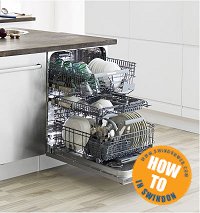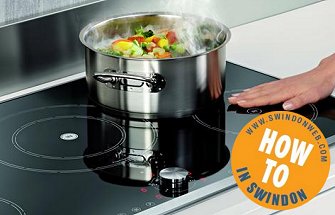Dishwasher
Away with the marrigolds! The best machine to wash those dirty plates in even the tiniest of kitchens
Not only do they save valuable time, they are also the most hygienic way of cleaning plates, cutlery and cooking utensils.
Available in various shapes and sizes they can be fitted/hidden in a kitchen - large or small - in a variety of ways.
First off...
There are a series of questions to ask yourself before you buy a dishwasher - some obvious and some not so:
1. Where is your dishwasher going to go?
2. Would you like a freestanding or built-in dishwasher?
3. How many place settings do you need?
4. How much will a dishwasher cost you in energy bills?
And if you didn't know.... one place setting generally represents a dinner plate, soup plate, desert plate, glass tumbler, tea cup & saucer, knife, fork, soup spoon, desert spoon and a teaspoon.
Dishwashers: The Basics
You can buy a dishwasher in three different sizes:
- full size
- slim-line
- compact
Full size
A full size dishwasher is usually:
- 600mm wide
- has a capacity of between 12 and 14 place settings
- ideal for families of four or more.
Dishwashers that have over 14 or more place-settings may vary in depth as they tend to be slightly deeper.
A full size dishwasher may be too big to fit into an existing kitchen.
Slimline
If space is a constraint, then a 450mm slim-line dishwasher is an option.
- 450mm wide
- capacity for up to 10 place settings
- may be the only option if you have a 500mm or smaller gap
Compact
With the wonders of modern design and electronics, compact dishwashers allow even the smallest of kitchens to have a quick and easy way to deal with washing up.
- width varies from 450/600mm
- capacity of 4 to 6 place settings
- similar size to a larger microwave oven
- can fit into cabinetry or will sit on a worktop
- use
more water and energy per item than slimline and full-sized machines.
In some cases, the control panels on compacts have the same aesthetic appearance as other product ranges such as ovens, microwaves and coffee machines.
Where To Put A Dishwasher and How To Fit It Into A Kitchen
A dishwasher can be fitted into a kitchen in a number of ways:
- free standing
- fully integrated
- semi integrated
- in-column.
Each, of course, has their own advantages and disadvantages.
Freestanding
Built-In Dishwasher
‘Built-in’ is when a dishwasher appears to be part of the kitchen furniture and are used in most modern kitchens as they create a clean, aesthetic design.
A panel matching the overall kitchen design is attached to the front of the appliance to conceal its appearance.
There are three types:
- fully integrated
- semi-integrated
- in-column
All three types of integrated machine are positioned between other units or under a worktop and are not intended to be visible from the sides or top.
Fully integrated
Fully integrated dishwashers are hidden behind a full height furniture panel and are operated by controls on the top edge of the dishwasher door, meaning that when the door of the machine is closed, no control panel is visible.
Full size and slim-line dishwashers can be fully integrated into a kitchen.
Semi-integrated
Semi-intgrated machines have a visible control panel, which matches in height to the surrounding drawer line furniture.
A three quarter length furniture door is affixed below the control panel.
In-column
In-column dishwashers are built into a tall housing at chest height.
They are easier to load and unload as they do not require you to bend down when you fill or empty a dishwasher.
In-column dishwashers are usually:
- 550mm wide
- have a capacity of 12 place settings.
Dishdrawer dishwasher
What's that? A Dishdrawer is a dishwasher that is also built into a kitchen but differs in the way that it opens.
As the name suggests, a Dishdrawer has draws that open and close.
Having draws makes this product more accessible as unlike other dishwashers, once you open the dishwasher door, you do not then have to pull out the dishwasher tray.
Each drawer cam operate independently, which offers the benefit of washing loads that require difference setting at the same time.
Dishwasher Fitting Essentials
Don't forget - and worth double-checking!
- it must sit near a water supply, a power point and waste pipe
- always have a professional, registered plumber fit a dishwasher
- a dishwasher normally requires a 13amp output
Energy Efficiency
The importance of owning an energy efficient dishwasher can not be underestimated.
Energy Efficiency Label
Every kitchen appliance will have an energy efficiency label.
The scale is simple to read, just remember:
A+++ is the most energy efficient... and
G is the least energy efficient
Water efficiency
Some dishwashers now use digital sensing technology which manages the amount of water in a cycle, water temperature and the length of the programme for maximum efficiency.
Noise!
Noise Contemporary dishwashers are all relatively quiet but some dishwashers will contain better sound dampeners than others which will reflect in their price.
A dishwasher’s noise level is measured in decibels and will be included in all product descriptions.
When considering the noise of a dishwasher, it is important to consider how often you will use a dishwasher and where it will go.
Anything under 55db is considered a fairly quiet machine.
Programs Explained
All those buttons and flashing things! But what should you press?!
Economy Wash
An economy wash is one of the most important programs on a dishwasher. Using this feature will save you money in the long term. It will wash at between 50 C to 55 C and takes a longer time to cycle.
Intensive Wash
An intensive wash will be between 65 C to 70 C and is used for baked-on, heavy stains. Many parents will also use this program to sterilise their baby bottles.
Normal Wash
For every day use Half Load - although you should always try to wash a full load, the half-load program allows you to wash smaller sized washing loads.
Delicate
The delicate program is ideal for washing items such as wine glasses.
Quick Wash
A quick wash will wash your utensils in a shorter space of time, offering more convenience for busy people.
Anti-Flood
If you can afford it, a wise investment.
God forbid, of course. But the longer you have a dishwasher, the more likely it is that it break which could lead to flooding the kitchen, most likely from a leak in the hose piping, or loose clamps holding the hose pipes in place.
Some machines now contain an anti-flooding device that can prevent any catastrophic repercussions if a washing machine does flood.
And finally....
A couple dishwasher energy saving tips to finish with.
To save money, you should
always try to wash a full load.
A half load wash setting usually uses more than half the energy of a full load, so it pays to wait until the machine is full.
Switch it off
Always remember to switch an appliance off stand-by when you have finished using it.
Appliance World
Located in Hobley Drive, Stratton St Margaret their showroom has over 200 items on show with 8 fully working kitchens allowing customers the rare opportunity to try before they buy.
Leading independents in Swindon also include Burden Electronics and Basics, who also deal in second-hand appliances.
|
|
||||||||
|
||||||||
|
||||||||
|
||||||||













